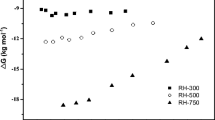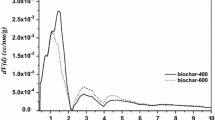Abstract
Biochar has attracted much attention, which owns many environmental and agronomic benefits, including carbon sequestration, improvement of soil quality, and immobilization of environmental contaminants. Biochar has been also investigated as an effective sorbent in recent publications. Generally, biochar particles can be divided into colloids and residues according to particle sizes, while understanding of adsorption capacities towards organic pollutants in each section is largely unknown, representing a critical knowledge gap in evaluations on the effectiveness of biochar for water treatment application. Scanning electron microscopy (SEM) images, X-ray diffraction (XRD), Raman spectra, Fourier-transform infrared spectroscopy (FTIR), X-ray photoelectron spectroscopy (XPS), and Brunauer-Emmett-Teller (BET) method are used to examine the structures and surface properties of biochar colloids and residues derived from corn straws prepared at different pyrolysis temperatures. Also, their roles in atrazine (a typical organic pollutant) removal are investigated by batch adsorption experiments and fitted by different kinetic and thermodynamic models, respectively. The adsorption capacities of biochar colloids are much more than those of residues, resulting from the colloids containing abundant oxygen functional groups and mineral substances, and the adsorption capacities of biochar colloids and residues increase with the increase of pyrolysis temperatures. The highest adsorption performance of 139.33 mg g−1 can be obtained in biochar colloids prepared at 700 °C, suggesting the important functions of biochar colloids in the application of atrazine removal by biochar.










Similar content being viewed by others
References
Alothman ZA (2012) A review: fundamental aspects of silicate mesoporous materials. Materials 5(12):2874–2902
Bennett D, Kastenberg WE, Mckone TE (1999) A multimedia, multiple pathway risk assessment of atrazine: the impact of age differentiated exposure including joint uncertainty and variability. Reliab Eng Syst Saf 63(2):185–198
Cantrell KB, Hunt PG, Uchimiya M, Novak JM, Ro KS (2012) Impact of pyrolysis temperature and manure source on physicochemical characteristics of biochar. Bioresour Technol 107(2):419–428
Cao X (2011) Colloid deposition and release in soils and their association with heavy metals. Crit Rev Environ Sci Technol 41(4):336–372
Chen B, Chen Z (2009) Sorption of naphthalene and 1-naphthol by biochars of orange peels with different pyrolytic temperatures. Chemosphere 76(1):127–133
Chen X, Chen B (2015) Macroscopic and spectroscopic investigations of the adsorption of nitroaromatic compounds on graphene oxide, reduced graphene oxide, and graphene nanosheets. Environ Sci Technol 49(10):6181–6189
Chen B, Zhou D, Zhu L (2008) Transitional adsorption and partition of nonpolar and polar aromatic contaminants by biochars of pine needles with different pyrolytic temperatures. Environ Sci Technol 42(14):5137–5143
Chen B, Yuan M, Qian L (2012) Enhanced bioremediation of PAH-contaminated soil by immobilized bacteria with plant residue and biochar as carriers. J Soils Sediments Protect Risk Assess Rem 12(9):1350–1359
Christin MS, Ménard L, Gendron AD, Ruby S, Cyr D, Marcogliese DJ, Rollinssmith L, Fournier M (2004) Effects of agricultural pesticides on the immune system of Xenopus laevis and Rana pipiens. Aquat Toxicol 67(1):33–43
Fang G, Liu C, Gao J, Dionysiou DD, Zhou D (2015) Manipulation of persistent free radicals in biochar to activate persulfate for contaminant degradation. Environ Sci Technol 49(9):5645–5653
Guo W, Huo S, Feng J, Lu X (2017) Adsorption of perfluorooctane sulfonate (PFOS) on corn straw-derived biochar prepared at different pyrolytic temperatures. J Taiwan Inst Chem Eng 78:265–271
Hockaday WC, Grannas AM, Kim S, Hatcher PG (2007) The transformation and mobility of charcoal in a fire-impacted watershed. Geochim Cosmochim Acta 71(14):3432–3445
Inoue J, Yoshie A, Tanaka T, Onji T, Inoue Y (2017) Disappearance and alteration process of charcoal fragments in cumulative soils studied using Raman spectroscopy. Geoderma 285(1):164–172
Kanti ST, Khilar KC (2006) Review on subsurface colloids and colloid-associated contaminant transport in saturated porous media. Adv Colloid Interf Sci 119(2–3):71–96
Kawamoto K, Ishimaru K, Imamura Y (2005) Reactivity of wood charcoal with ozone. J Wood Sci 51(1):66–72
Keiluweit M, Nico PS, Johnson MG, Kleber M (2010) Dynamic molecular structure of plant biomass-derived black carbon (biochar). Environ Sci Technol 44(4):1247–1253
Khan JA, He X, Shah NS, Sayed M, Khan HM, Dionysiou DD (2017) Degradation kinetics and mechanism of desethyl-atrazine and desisopropyl-atrazine in water with OH and SO4-based AOPs. Chem Eng J 325(Supplement C):485–494
Koppolu L, Prasad R, Clements LD (2004) Pyrolysis as a technique for separating heavy metals from hyperaccumulators. Part III: pilot-scale pyrolysis of synthetic hyperaccumulator biomass. Biomass Bioenergy 26(5):463–472
Lazar P, Karlický F, Jurečka P, Kocman M, Otyepková E, Safarova K, Otyepka M (2013) Adsorption of small organic molecules on graphene. J Am Chem Soc 135(16):6372–6377
Lehmann J, Joseph S (2009) Biochar for environmental management: science and technology. Sci Technol Earthscan 25(1):15801–15811(15811)
Lehmann J, Gaunt J, Rondon M (2006) Bio-char sequestration in terrestrial ecosystems—a review. Mitig Adapt Strateg Glob Chang 11(2):395–419
Leifeld J, Fenner S, Müller M (2007) Mobility of black carbon in drained peatland soils. Biogeosciences 4(2):425–432
Liang B, Lehmann J, Solomon D, Kinyangi J, Grossman J, O’Neill B, Skjemstad JO, Thies J, Luizão FJ, Petersen J (2006) Black carbon increases cation exchange capacity in soil. Soil Sci Soc Am J 70(5):1719–1730
Lievens C, Yperman J, Vangronsveld J, Carleer R (2008) Study of the potential valorisation of heavy metal contaminated biomass via phytoremediation by fast pyrolysis: part I. Influence of temperature, biomass species and solid heat carrier on the behaviour of heavy metals. Fuel 87(10–11):1894–1905
Lin C, Liu C, Zhou G, Rui X, Tang Y, Zeng Z, Luo S (2015) A double network gel as low cost and easy recycle adsorbent: highly efficient removal of Cd(II) and Pb(II) pollutants from wastewater. J Hazard Mater 300:153
Liu WJ, Zeng FX, Jiang H, Zhang XS, Yu HQ (2011) Techno-economic evaluation of the integrated biosorption-pyrolysis technology for lead (Pb) recovery from aqueous solution. Bioresour Technol 102(10):6260–6265
Liu M, Jia S, Gong Y, Song C, Guo X (2013) Effective hydrolysis of cellulose into glucose over sulfonated sugar-derived carbon in an ionic liquid. Ind Eng Chem Res 52(24):8167–8173
Ma L, Chen S, Yuan J, Yang P, Liu Y, Stewart K (2017) Rapid biodegradation of atrazine by Ensifer sp. strain and its degradation genes. Int Biodeterior Biodegrad 116:133–140
Moreira AJ, Borges AC, Gouvea LFC, MacLeod TCO, Freschi GPG (2017) The process of atrazine degradation, its mechanism, and the formation of metabolites using UV and UV/MW photolysis. J Photochem Photobiol A Chem 347(Supplement C):160–167
Pereira WE, Rostad CE (1990) Occurrence, distributions, and transport of herbicides and their degradation products in the Lower Mississippi River and its tributaries. Environ Sci Technol 24(9):1400–1406
Qian L, Zhang W, Yan J, Han L, Gao W, Liu R, Chen M (2016) Effective removal of heavy metal by biochar colloids under different pyrolysis temperatures. Bioresour Technol 206:217–224
Santos EVD, Sáez C, Martínez-Huitle CA, Cañizares P, Rodrigo MA (2015) The role of particle size on the conductive diamond electrochemical oxidation of soil-washing effluent polluted with atrazine. Electrochem Commun 55:26–29
Schmidt MWI, Noack AG (2000) Black carbon in soils and sediments: analysis, distribution, implications, and current challenges. Glob Biogeochem Cycles 14(3):777–793
Sheng GD, Shao DD, Ren XM, Wang XQ, Li JX, Chen YX, Wang XK (2010) Kinetics and thermodynamics of adsorption of ionizable aromatic compounds from aqueous solutions by as-prepared and oxidized multiwalled carbon nanotubes. J Hazard Mater 178(1–3):505–516
Tsaneva VN, Kwapinski W, Teng X, Glowacki BA (2014) Assessment of the structural evolution of carbons from microwave plasma natural gas reforming and biomass pyrolysis using Raman spectroscopy. Carbon 80(1):617–628
Uchimiya M, Llma IM, Klasson KT (2010) Immobilization of heavy metal ions (CuII, CdII, NiII, and PbII) by broiler litter-derived biochars in water and soil. J Agric Food Chem 58(9):5538–5544
Uchimiya M, Wartelle LH, Klasson KT, Fortier CA, Lima IM (2011) Influence of pyrolysis temperature on biochar property and function as a heavy metal sorbent in soil. J Agric Food Chem 59(6):2501–2510
Wang J, Chen B (2015) Adsorption and coadsorption of organic pollutants and a heavy metal by graphene oxide and reduced graphene materials. Chem Eng J 281:379–388
Wang D, Zhang W, Hao X, Zhou D (2013) Transport of biochar particles in saturated granular media: effects of pyrolysis temperature and particle size. Environ Sci Technol 47(2):821–828
Wang J, Chen Z, Chen B (2014) Adsorption of polycyclic aromatic hydrocarbons by graphene and graphene oxide nanosheets. Environ Sci Technol 48(9):4817–4825
Xiao X, Chen B (2017) A direct observation of the fine aromatic clusters and molecular structures of biochars. Environ Sci Technol 51:5473–5482
Yan J, Han L, Gao W, Xue S, Chen M (2015) Biochar supported nanoscale zerovalent iron composite used as persulfate activator for removing trichloroethylene. Bioresour Technol 175:269–274
Yang K, Wang J, Chen B (2014) Facile fabrication of stable monolayer and few-layer graphene nanosheets as superior sorbents for persistent aromatic pollutant management in water. J Mater Chem A 2(43):18219–18224
Yang F, Sun L, Xie W, Jiang Q, Gao Y, Zhang W, Zhang Y (2017a) Nitrogen-functionalization biochars derived from wheat straws via molten salt synthesis: an efficient adsorbent for atrazine removal. Sci Total Environ 607-608(Supplement C):1391–1399
Yang F, Sun L, Zhang W, Zhang Y (2017b) One-pot synthesis of porous carbon foam derived from corn straw: atrazine adsorption equilibrium and kinetics. Environ Sci Nano 4(3):625–635
Yang X, Wei H, Zhu C, Geng B (2018) Biodegradation of atrazine by the novel Citricoccus sp. strain TT3. Ecotoxicol Environ Saf 147(Supplement C):144–150
Zhang X, Wang H, He L, Lu K, Sarmah A, Li J, Bolan NS, Pei J, Huang H (2013) Using biochar for remediation of soils contaminated with heavy metals and organic pollutants. Environ Sci Pollut Res Int 20(12):8472–8483
Zhang Y, Cao B, Zhao L, Sun L, Gao Y, Li J, Yang F (2018) Biochar-supported reduced graphene oxide composite for adsorption and coadsorption of atrazine and lead ions. Appl Surf Sci 427(Part A):147–155
Zhao J, Wang Z, Zhao Q, Xing B (2014) Adsorption of phenanthrene on multilayer graphene as affected by surfactant and exfoliation. Environ Sci Technol 48(1):331–339
Zhao Y, Feng D, Zhang Y, Huang Y, Sun S (2016) Effect of pyrolysis temperature on char structure and chemical speciation of alkali and alkaline earth metallic species in biochar. Fuel Process Technol 141(2):54–60
Zhao L, Yang F, Jiang Q, Zhu M, Jiang Z, Tang Y, Zhang Y (2018) Characterization of modified biochars prepared at low pyrolysis temperature as an efficient adsorbent for atrazine removal. Environ Sci Pollut Res 25(2):1405–1417
Zimmerman AR (2010) Abiotic and microbial oxidation of laboratory-produced black carbon (biochar). Environ Sci Technol 44(4):1295–1301
Funding
We gratefully acknowledge the financial support of this research by the National Nature Science Fund for Young Scholars (31600413), the National Nature Science Fund for Distinguished Young Scholars (41625002), the MOA Modern Agricultural Talents Support Project, the China Postdoctoral Science Foundation (2017T100222 and 2015M581417), the Heilongjiang Postdoctoral Fund (LBH-Z15012 and LBH-TZ1603), and “Young Talents” Project of Northeast Agricultural University (16QC34 and 17XG03).
Author information
Authors and Affiliations
Corresponding author
Additional information
Responsible editor: Guilherme L. Dotto
Electronic supplementary material
ESM 1
(DOCX 1027 kb)
Rights and permissions
About this article
Cite this article
Yang, F., Gao, Y., Sun, L. et al. Effective sorption of atrazine by biochar colloids and residues derived from different pyrolysis temperatures. Environ Sci Pollut Res 25, 18528–18539 (2018). https://doi.org/10.1007/s11356-018-2077-0
Received:
Accepted:
Published:
Issue Date:
DOI: https://doi.org/10.1007/s11356-018-2077-0




